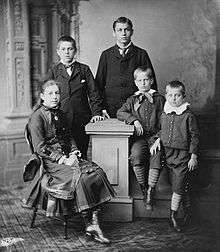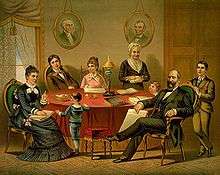Lucretia Garfield
| Lucretia Garfield | |
|---|---|
 | |
| First Lady of the United States | |
|
In role March 4, 1881 – September 19, 1881 | |
| President | James Garfield |
| Preceded by | Lucy Hayes |
| Succeeded by | Mary McElroy (De facto) |
| Personal details | |
| Born |
April 19, 1832 Garrettsville, Ohio, U.S. |
| Died |
March 14, 1918 (aged 85) South Pasadena, California, U.S. |
| Spouse(s) | James Garfield (1858–1881) |
| Children |
Hal James Mary Irvin Abram Eliza Edward |
| Alma mater |
Geauga Seminary Hiram College |
| Religion | Churches of Christ |
| Signature |
|
Lucretia Rudolph Garfield (April 19, 1832 – March 14, 1918), wife of James A. Garfield, was First Lady of the United States in 1881.
Early life
Born in Hiram, Ohio, the daughter of Zeb Rudolph, a farmer and co-founder of the Eclectic Institute at Hiram, and Arabella Mason Rudolph, Lucretia "Crete" Rudolph was a devout member of the Churches of Christ. Her ancestry includes German, Welsh, English and Irish; Lucretia Garfield's paternal great-grandfather immigrated to Pennsylvania (in a part that is now Delaware) from Württemberg, Germany.
Romance and marriage

She first met James Garfield in 1849 when they were classmates at Geauga Seminary in Chester, Ohio, and followed him to the Eclectic Institute, where he began courting her. Garfield was attracted to her keen intellect and appetite for knowledge. While Garfield went on to Williams College, she taught school in Cleveland, Ohio and Bayou, Ohio. They had planned to marry on his graduation in 1856, but decided to postpone the wedding for a couple of years until he was earning more money.
Both James and Crete were 26 when they married on November 11, 1858 at the home of the bride's parents in Hiram. Although both were members of the churches of Christ, the nuptials were performed by Henry Hitchcock, a Presbyterian minister. The newlyweds did not take a honeymoon but instead set up housekeeping immediately in Hiram.
His service in the Union Army from 1861 to 1863 kept them apart. But after his first winter in Washington as a freshman Representative, the family remained together. With a home in the capital as well as one (Lawnfield) in Mentor, Ohio, they enjoyed a happy domestic life.
In Washington, D.C. they shared intellectual interests with congenial friends; she went with him to meetings of a locally celebrated literary society. They read together, made social calls together, dined with each other, and traveled in company until by 1880 they were as nearly inseparable as his career permitted.
Children

The Garfields had seven children. Two died in early childhood: Eliza Arabella "Trot" Garfield (1860-1863) and Edward Garfield (1874-1876). Four sons and a daughter lived to maturity:
- Harry Augustus Garfield (1863–1942) - lawyer, educator, public official.
- James Rudolph Garfield (1865–1950) - lawyer, public official.
- Mary "Mollie" Garfield Stanley-Brown (1867–1947). Educated at private schools in Cleveland and Connecticut, she in 1888 married Joseph Stanley-Brown, presidential secretary during Garfield's term, later an investment banker. She lived in New York and Pasadena, CA.
- Irvin McDowell Garfield (1870–1951) - lawyer. He followed his older brothers to Williams College and Columbia Law School. He settled in Boston, where he prospered as partner in the firm of Warren & Garfield and served on the boards of directors of several corporations.
- Abram Garfield (1872–1958) - architect. A graduate of Williams College and Massachusetts Institute of Technology, he settled in Cleveland, where he worked as an architect from offices in the James A. Garfield Building. He served as chairman of the Cleveland Planning Commission 1929-1942 and was active in the American Institute of Architects.
First Lady of the United States

Garfield's election to the presidency brought a cheerful family to the White House in 1881. Though Mrs. Garfield was not particularly interested in a First Lady's social duties, she was deeply conscientious and her genuine hospitality made her dinners and twice-weekly receptions enjoyable. At the age of 49 she was still a slender, graceful little woman with clear dark eyes, her brown hair beginning to show traces of silver.
As First Lady, Mrs. Garfield researched the history of the White House furnishings with a view to restoring it to its former glory, but she contracted malaria and was unable to pursue the project.
She was still a convalescent, at Elberon, a seaside resort in New Jersey, when her husband was shot by Charles Guiteau on July 2 at a railway station in Washington. The President was actually planning to take a train north to New Jersey that same day in order to meet his wife, before continuing on to a function at his former college in Massachusetts. The First Lady hurriedly returned to Washington by special train -- "frail, fatigued, desperate," reported an eyewitness at the White House, "but firm and quiet and full of purpose to save." As her train raced south, it was speeding so fast that the engine broke a piston in Bowie, Maryland and nearly derailed. Mrs. Garfield was thrown from her seat, but not injured. After an anxious delay, she reached the White House and immediately went to her husband's bedside.
During the three months that the President fought for his life, her grief and devotion won the respect and sympathy of the country. On the night of Garfield's death, according to the doctor, she exclaimed, "Oh, why am I made to suffer this cruel wrong?" After his death and funeral, the bereaved family went home to their farm in northern Ohio. For another 36 years she led a strictly private, but busy and comfortable life, active in preserving the records of her husband's career. She created a wing to the home that became a presidential library of his papers.
Later life and death
She lived comfortably on a $350,000 trust fund raised for her and the Garfield children by financier Cyrus W. Field. She spent winters in South Pasadena, where she built a home designed by the celebrated architects Greene and Greene to whom she was distantly related. She died at her home in South Pasadena, California on March 14, 1918. Her casket was placed above ground beside the coffin of her husband in the lower level crypt of the James A. Garfield Memorial at Lake View Cemetery in Cleveland, Ohio.
External links
![]() Media related to Lucretia Garfield at Wikimedia Commons
Media related to Lucretia Garfield at Wikimedia Commons
- Find a Grave
- Original text based on White House biography
- Lucretia Garfield at C-SPAN's First Ladies: Influence & Image
| Honorary titles | ||
|---|---|---|
| Preceded by Lucy Hayes |
First Lady of the United States 1881 |
Succeeded by Mary McElroy De facto |
